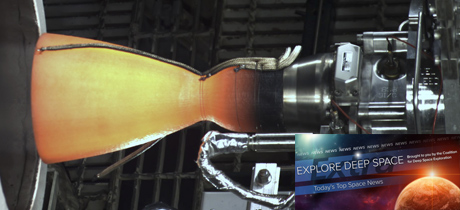In Today’s Deep Space Extra… The President’s assurances about establishing a space corps, and about human explorers to Mars in the near future, fall under scrutiny. NASA’s Deep Space Network, utilized for science missions and a lot more, is in need of more funding. China’s next moon mission, Chang’e 4, a soft landing on the moon’s far side, is prepared to launch in two phases this year. Three U.S. and Russian astronauts launch to the International Space Station this week.
Human Space Flight
Donald Trump said America is going to Mars. Here’s why that won’t happen any time soon
Time (3/16): While the White House National Space Council pursues a strategy that refocuses NASA’s human space exploration endeavors from the International Space Station and low Earth orbit to the lunar environs, the president has expressed a desire for a military space corps and human expeditions to Mars. The U.S. military has questioned the first and it may violate current international treaties intended to keep weapons from space. As for Mars soon, NASA’s current budget lacks the dollars.
CST-100 Starliner re-entry thrusters delivered
Coalition Members in the News – Aerojet Rocketdyne, Boeing
Spaceflightinsider.com (3/18): Thrusters manufactured by Aerojet Rocketdyne and designed to orient Boeing’s CST-100 Starliner capsule for re-entry have been delivered to spacecraft assembly facilities at NASA’s Kennedy Space Center. An uncrewed test flight is planned for no earlier than late August. The CST-100 Starliner is being developed under NASA’s Commercial Crew Program to transport astronauts to and from the International Space Station.
SpaceX: We’ll fly life support on uncrewed Dragon test flight
Florida Today (3/16): Space X offers assurances that it will have life support hardware aboard as it carries out its unmanned test flight of the crewed Dragon capsule it is developing under NASA’s Commercial Crew Program to transport astronauts to and from the International Space Station. The uncrewed test flight is targeted for a Falcon 9 launch from the Kennedy Space Center in August.
Space Science
Welcome to the center of the universe
Longreads.com (March): The flight control room at NASA’s Jet Propulsion Laboratory watches over the nation’s deep space probes. Opened in 1963, the facility, its personnel and those who bring support around the world have been at the ready 24/7 and operating the Deep Space Network ever since. Now, the facility and its hardware are showing their age and their vulnerability. It’s time for more money.
China outlines two-phase Chang’e 4 moon lander mission
Space.com (3/16): China’s ambitious Chang’e 4 lunar mission is to unfold in two phases. The first included the Chang’e 1 and 2 missions of 2007 and 2010. Their lunar reconnaissance set the stage for the start of the second phase, Chang’e 3, which carried out Beijing’s first ever lunar soft landing and deployed a small rover, Yutu. Chang’e 4, was assembled as a backup to its predecessor but significantly upgraded. Its mission will begin soon with the launch of a lunar telecommunications satellite and also a soft landing on the moon’s far side.
Other news
NASA investigation linked 2015 Falcon 9 failure to design error
Space News (3/16): A NASA investigation into a 2015 SpaceX launch failure concluded a design flaw, rather than a manufacturing defect, likely initiated the chain of events that destroyed the vehicle. NASA released a public summary of the report by an independent review team convened by NASA after the June 2015 accident during the launch of a Dragon cargo spacecraft bound for the International Space Station, a mission known as CRS-7. That investigation was performed by NASA’s Launch Services Program at the request of the agency’s associate administrator for human exploration and operations, Bill Gerstenmaier, in parallel with SpaceX’s own investigation into the failure.
Tiangong-1: ESA re-entry window estimate narrows to March 30-April 6
GB Times of Finland (3/16): European experts have narrowed the window for the uncontrolled re-entry of China’s 8 1/2 ton, orbiting Tiangong-1 space lab to between March 30 and April 6. Currently unstaffed, Tiangong-1 was launched in 2011 and used as a test bed for the Shenzhou manned spacecraft and a new space station, whose first component awaits launching in 2020.
China to launch first commercial recoverable satellite by 2020
Xinhuanet of China (3/17): China plans to offer commercial customers payload launches aboard orbiting satellites that return to Earth. The technology is similar to those that launch Chinese astronauts on missions.
Lost in space: Why Canada’s diminishing role in the heavens is a problem
Globe and Mail of Canada (3/13): Despite some key milestones in space this year and next, including the late 2018 launch of physician astronaut David-Saint Jacques to the International Space Station, Canada may be losing ground in the arena, according to the report. “Unfortunately, there’s nothing in the pipeline, and it’s going to hit home in another year or two,” says Gordon Osinski, a planetary scientist at the University of Western Ontario and a member of a government-selected advisory board on Canada’s space program.
Fourth satellite in new Chinese spy fleet successfully launched
Spaceflightnow.com (3/18): China launched the latest of four reconnaissance satellites on Saturday. The Long March 2 rocket placed the spacecraft in a highly inclined orbit.
Major Space Related Activities for the Week
Major space related activities for the week of March 18-23, 2018
Spacepolicyonline.com (3/18): The latest U.S. 2018 budget continuing resolution expires this Friday at midnight, leaving open the possibility of a federal government shutdown, though that seems something most in the House, White House and Senate don’t really want. NASA astronauts Ricky Arnold, Drew Feustel and cosmonaut Oleg Artemyev launch to the International Space Station from Kazakhstan aboard their Soyuz MS-08 spacecraft on Wednesday. They dock on Friday. In Washington, Congressional oversight and appropriations committees are at work on the White House’s 2019 budget request. The annual Lunar and Planetary Science Conference is underway this week in The Woodlands, outside Houston.

